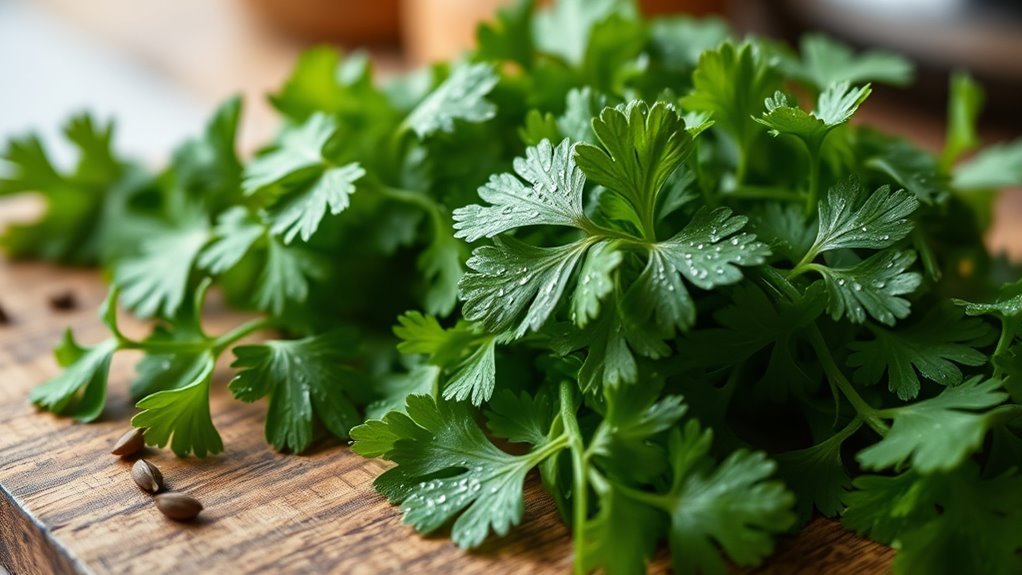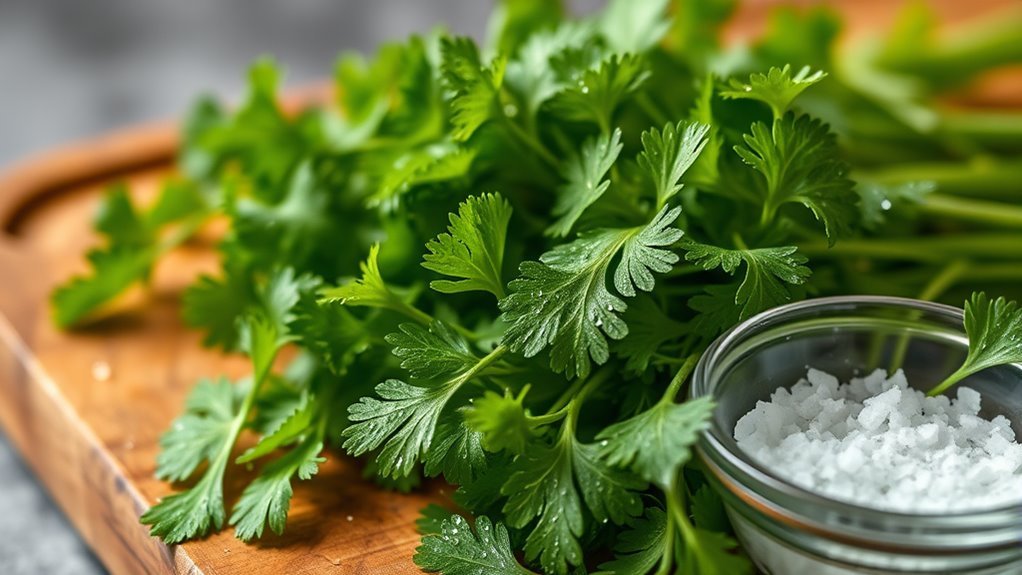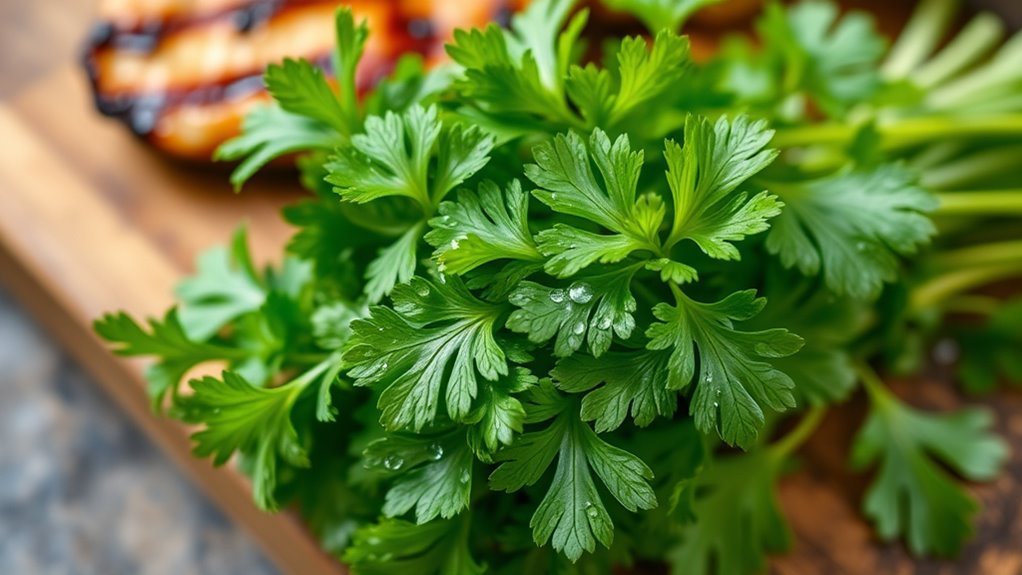Yes, cilantro is keto-friendly! With only 0.1 grams of carbohydrates per 2 tablespoons, it won’t interfere with your carb limits. Plus, it’s packed with vitamins A, C, and K, along with antioxidants that reduce inflammation and support heart health. You can easily incorporate it into your meals, enhancing flavors without adding significant calories. If you’re curious about how to make the most of cilantro in your keto dishes, there’s plenty more to explore.
Nutritional Profile of Cilantro

Cilantro, often celebrated for its fresh, vibrant flavor, also boasts a compelling nutritional profile that can complement a keto diet. Rich in vitamins A, C, and K, cilantro offers numerous health benefits without adding significant calories. Its antioxidants contribute to reducing inflammation, promoting heart health, and supporting digestion. Incorporating cilantro into your meals can enhance both flavor and nutrition, making it a versatile herb for salads, salsas, and marinades. You can easily use fresh cilantro to elevate your dishes while benefiting from its unique nutrients. Whether you’re looking to spice up your favorite keto recipes or seeking additional health advantages, exploring cilantro usage is a delicious way to support your wellness journey while enjoying culinary freedom.
Carbohydrate Content in Cilantro

When considering cilantro for your keto diet, it’s important to understand its carbohydrate content. A typical serving of cilantro contains minimal carbs, making it a suitable choice compared to many other herbs. By examining its nutritional profile alongside others, you can make informed decisions about how to incorporate it into your meals.
Nutritional Profile Overview
Herb enthusiasts often appreciate cilantro not just for its distinct flavor but also for its nutritional benefits. When you explore the various cilantro varieties, you’ll find they all share a low carbohydrate content, making them suitable for your culinary uses without compromising your dietary goals. Here’s a quick overview of cilantro’s nutritional profile:
- Low in Carbs: Cilantro is very low in carbohydrates, allowing for more flexibility in meal planning.
- Rich in Vitamins: It contains vitamins A, C, and K, supporting your overall health.
- Antioxidant Properties: Cilantro boasts antioxidants that may help reduce inflammation.
- Mineral Content: It includes essential minerals like potassium and calcium, contributing to balanced nutrition.
Incorporating cilantro into your diet can enhance flavor while keeping carb intake in check.
Carbs in Serving Size
A typical serving of cilantro, about two tablespoons (or roughly 8 grams), contains a mere 0.1 grams of carbohydrates. This incredibly low carb count makes cilantro an excellent choice for anyone following a keto diet. You can freely add cilantro to your meals without worrying about exceeding your daily carbohydrate limits. It not only enhances flavor but also provides essential vitamins and minerals. Plus, with such a minimal impact on your carb intake, you can enjoy the fresh taste of cilantro in salads, salsas, or as a garnish. So, if you’re looking for ways to spice up your keto meals, consider incorporating a cilantro serving to boost flavor without compromising your dietary goals.
Comparison With Other Herbs
While cilantro is low in carbohydrates, it’s helpful to compare it with other commonly used herbs to understand its place in a keto diet. Here’s a quick look at the carb content in some popular herbs:
- Basil: About 0.1 grams of carbs per tablespoon, adding a sweet, peppery note.
- Parsley: Contains roughly 0.2 grams of carbs, known for its fresh, green flavor.
- Thyme: Offers about 0.3 grams of carbs, with earthy and floral notes.
- Oregano: Has around 0.4 grams of carbs, bringing a robust, warm flavor.
When you think about herb comparisons, cilantro’s flavors shine with its unique zest, making it a fantastic choice for those looking to enhance meals without worrying about carbs.
Health Benefits of Cilantro

Cilantro offers a range of health benefits that can enhance your well-being, especially if you’re following a keto diet. It’s packed with antioxidants and possesses anti-inflammatory properties, which can contribute to your overall health. Plus, cilantro supports your immune system, helping you fend off illnesses.
Here’s a quick overview of cilantro’s health benefits:
| Benefit | Description | Evidence |
|---|---|---|
| Antioxidant Effects | Fights free radicals | Studies show reduced oxidative stress |
| Anti-inflammatory | May reduce inflammation | Linked to lower markers of inflammation |
| Immune Support | Boosts your immune response | Contains vitamins A and C |
| Digestive Health | Aids digestion and gut health | Promotes healthy gut flora |
Incorporating cilantro into your meals can be a delicious way to enjoy these benefits!
Cilantro and Ketosis
When you’re on a keto diet, understanding the nutritional profile of cilantro can be helpful. This herb is low in carbohydrates and rich in essential vitamins and minerals, making it a great addition to your meals without affecting ketosis. Let’s explore how cilantro can fit into your low-carb lifestyle and its potential impact on your overall state of ketosis.
Nutritional Profile Overview
Although many herbs and vegetables are often scrutinized for their carb content in a ketogenic diet, cilantro stands out due to its impressive nutritional profile. With origins tracing back to the Mediterranean and various varieties cultivated worldwide, cilantro offers more than just flavor. Here’s what makes it a great addition to your keto meals:
- Low in Carbs: Only about 1 gram of carbs per 100 grams.
- Rich in Vitamins: High in Vitamin K, essential for bone health.
- Antioxidant Properties: Contains compounds that combat oxidative stress.
- Mineral Content: Provides magnesium, which supports muscle and nerve function.
Incorporating cilantro into your diet not only enhances taste but also contributes beneficial nutrients without compromising your keto goals.
Impact on Ketosis
While many people are concerned about maintaining ketosis on a low-carb diet, incorporating cilantro can actually support your efforts. This herb is low in carbohydrates, making it an excellent addition to your list of keto ingredients. Cilantro benefits include its ability to enhance the flavor of dishes without adding significant calories or carbs, allowing you to enjoy variety in your meals. Additionally, it contains antioxidants that may help reduce inflammation, which can be beneficial when you’re adapting to a ketogenic lifestyle. By using cilantro in salads, sauces, or marinades, you can elevate your dishes while staying within your macro limits. Embracing cilantro not only keeps your meals interesting but also aligns with your goal of achieving and maintaining ketosis.
Incorporating Cilantro Into Your Keto Meals
Cilantro can elevate your keto meals by adding a burst of flavor without adding extra carbs. Not only does it enhance the taste of your dishes, but it also offers various cilantro benefits, such as potential anti-inflammatory properties. Here are some great ways to incorporate cilantro into your keto dishes:
Enhance your keto meals with cilantro for flavor and potential health benefits without the extra carbs.
- Garnish your avocado salads for a fresh finish.
- Blend it into your homemade pesto for an unexpected twist.
- Stir it into your cauliflower rice for added zest.
- Mix it into your marinades to infuse grilled meats with a vibrant flavor.
Cilantro Recipes for a Ketogenic Diet
Adding cilantro to your keto meals not only enhances flavor but can also inspire a variety of delicious recipes that align with your dietary goals. One great option is cilantro pesto, which you can whip up by blending fresh cilantro with olive oil, nuts, garlic, and Parmesan cheese. This zesty sauce can elevate your meals, whether you use it as a dressing or a dip. Another fantastic choice is a cilantro salad, combining fresh greens, avocado, lime juice, and chopped cilantro for a revitalizing side. These recipes are not only low in carbs but also packed with nutrients. They provide a burst of flavor, making your ketogenic journey enjoyable and satisfying while keeping you on track with your health objectives.
Potential Concerns With Cilantro on Keto
What should you consider when incorporating cilantro into your ketogenic diet? While cilantro can add flavor and nutrients, there are a few potential concerns to keep in mind:
- Cilantro Allergies: Some people may experience allergic reactions, causing symptoms like rashes or digestive discomfort. Always pay attention to your body’s signals.
- Cilantro Storage: Proper storage is essential. If not stored correctly, cilantro can wilt and lose its flavor, impacting your meals.
- Contamination Risk: Fresh herbs can harbor bacteria, so wash thoroughly before use to guarantee your safety.
- Interactions: Cilantro may interact with certain medications. If you’re on medication, consult with a healthcare professional before adding it to your diet.
Being informed helps you enjoy cilantro while maintaining your keto journey!
Alternatives to Cilantro in Keto Cooking
While many enjoy cilantro for its unique flavor, it’s not the only herb you can use in keto cooking. If you’re looking for cilantro substitutions, consider fresh parsley, which offers a milder taste and pairs well with various dishes. Basil is another excellent herb alternative; its sweet aroma can elevate salads and sauces alike. For a bolder flavor, try mint, which adds a invigorating twist to meats and veggies. Dill is also a great option, especially for seafood and pickled dishes. These herbs not only fit within your keto lifestyle but also provide diverse flavors to keep your meals exciting. Experimenting with these alternatives can enhance your culinary experience without sacrificing your dietary goals.
Frequently Asked Questions
Can Cilantro Help Reduce Cravings on a Keto Diet?
Cilantro can aid in craving control on a keto diet. Its unique flavor can enhance meals, making them more satisfying, which might help curb the desire for high-carb foods. Additionally, cilantro’s antioxidants may support overall health, adding to the keto benefits. While it won’t eliminate cravings entirely, incorporating it into your meals can provide a flavorful way to stay on track and enjoy your journey towards better health and freedom.
Is Cilantro Safe for Those With Herb Allergies?
If you have herb allergies, it’s essential to be cautious with cilantro. Some individuals may experience cilantro reactions, ranging from mild to severe. While cilantro is generally considered safe for many, those with specific herb sensitivities could face allergic responses. It’s best to consult a healthcare professional if you’re unsure about your allergies. Keeping an eye on your body’s reactions will empower you to make informed choices about adding cilantro to your diet.
How Does Cilantro Taste When Cooked Versus Raw?
When you taste cilantro raw, you’ll notice its bright, fresh flavor with a citrusy undertone. This raw flavor can add a vibrant kick to salads and salsas. When cilantro’s cooked, its flavor mellows considerably, becoming more earthy and slightly nutty. The cooked flavor can blend seamlessly into soups or stews, enhancing the overall dish without overpowering it. So, depending on your dish, you might prefer either the boldness of raw or the subtlety of cooked cilantro.
Can Cilantro Be Grown Easily at Home?
If you’re dreaming of a little green paradise, growing cilantro at home is quite attainable! It thrives in well-drained soil and needs plenty of sunlight, so indoor gardening can be a delightful venture. Just keep the growing conditions in mind: moderate temperatures and regular watering are key. With a bit of care, you’ll soon be snipping fresh cilantro for your dishes, adding a burst of flavor straight from your own garden!
What Are Some Common Misconceptions About Cilantro?
You might think cilantro’s just a garnish, but that’s a common misconception. Many underestimate its health benefits, like its ability to detoxify heavy metals and boost digestion. Some myths suggest it’s only for certain cuisines, but it can enhance various dishes. Also, people often confuse cilantro with parsley, despite their distinct flavors. Understanding these cilantro myths can help you appreciate its versatility and nutritional value in your cooking.


